All Posts > Fruit Trees > Perennials > Plant Profiles
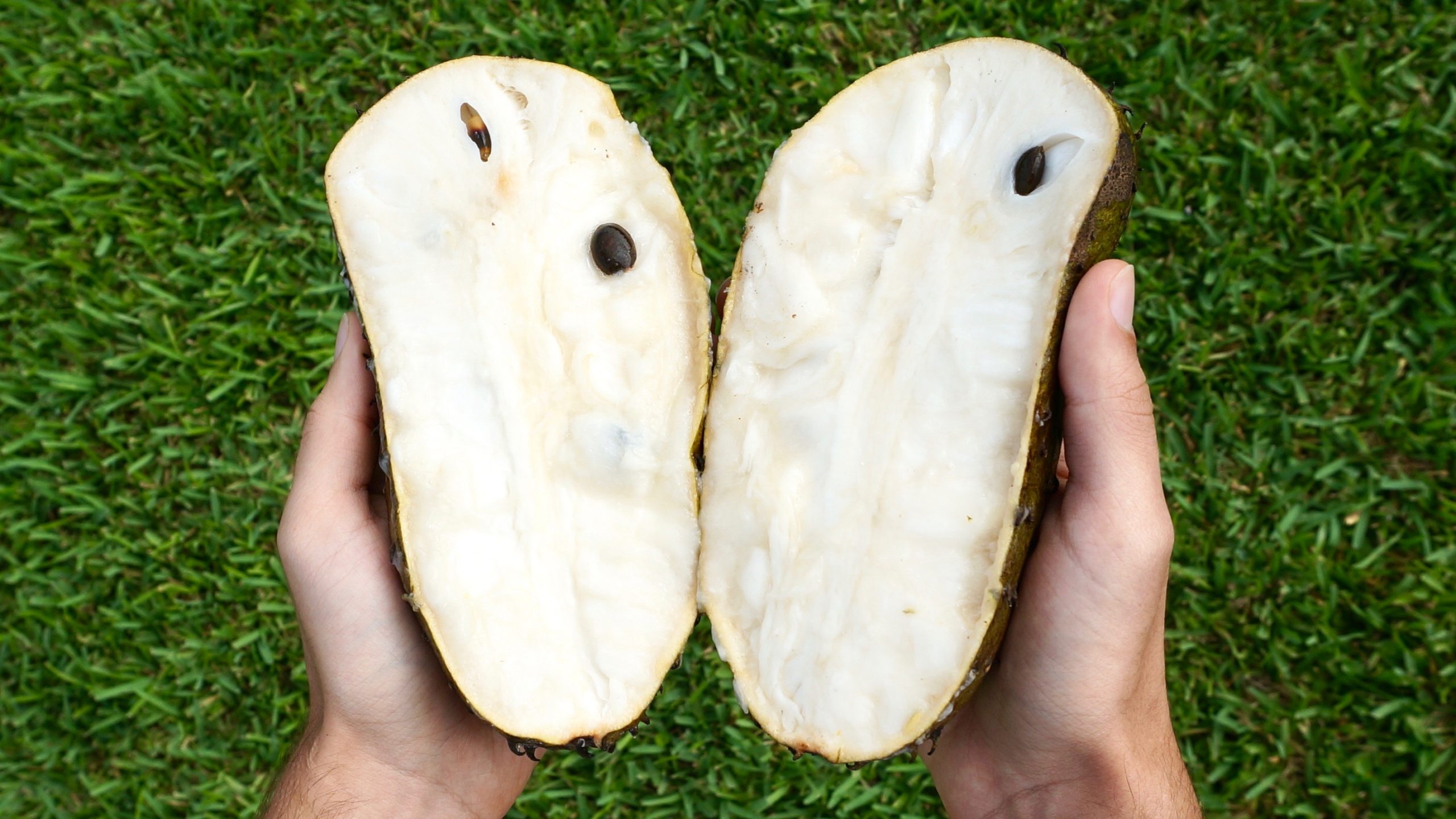
Introducing the Soursop
The soursop is a popular large tropical fruit. The flesh is creamy and white with a refreshing sweet and sour flavor. The soursop belongs to the family Annonaceae, which is also known as the Annona family. Another popular member of this family is the sugar apple, where you can read more about here.
The soursop is known all across the tropical regions in America. In these regions it is called “guanabana,” It is believed to be native to the tropical Americas. Today it is seen growing both wild and cultivated throughout the Caribbean and Central and South America. During colonial times this fruit was introduced to the Pacific Islands and the warm regions of Asia, Australia, and Africa. It is now grown in all tropical regions of the world where the local people eat it as a fresh fruit or use it in certain recipes. Some commercial growers also grow the fruit for processing and export.
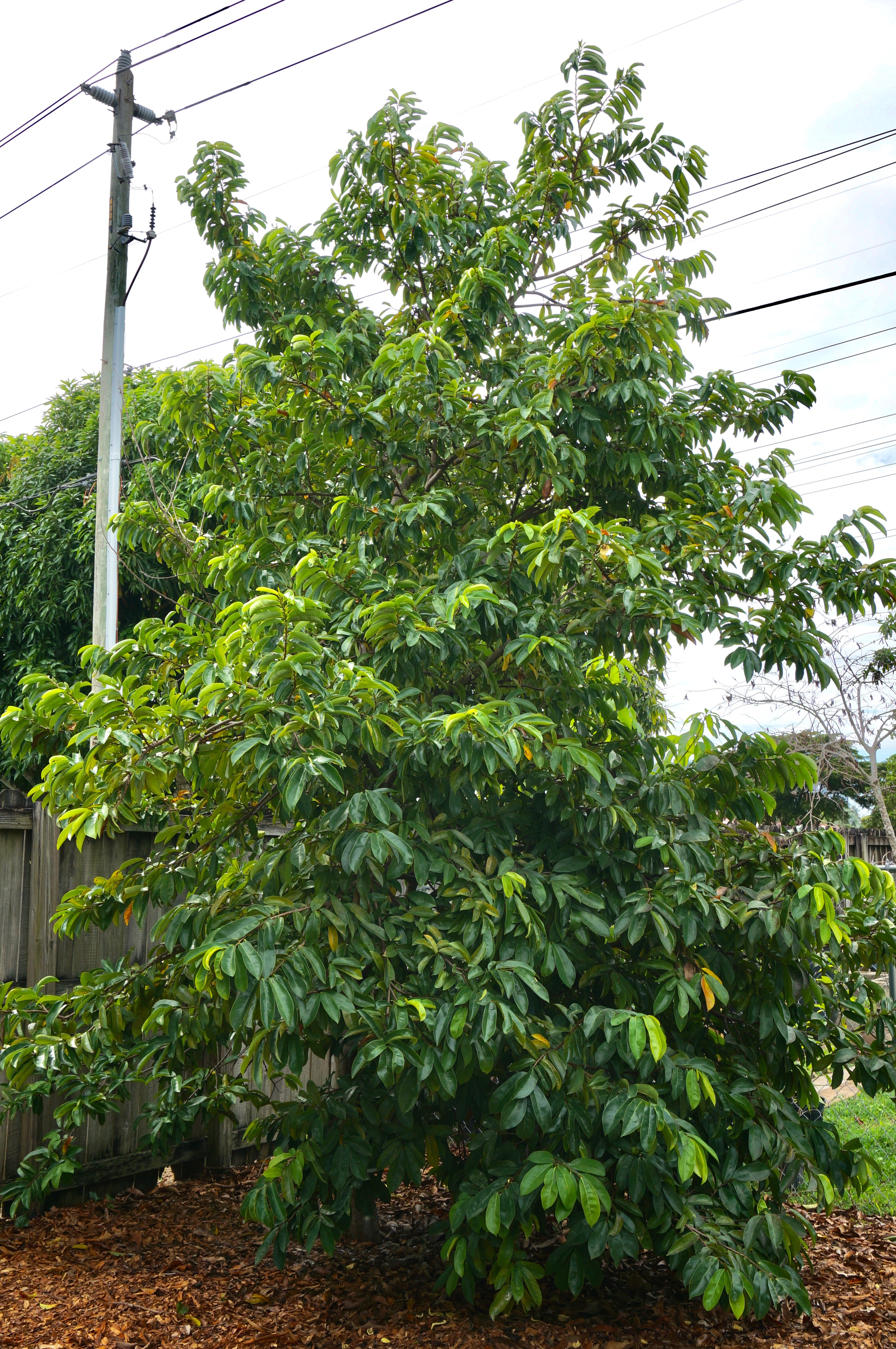
Growth Habit of the Tree
The soursop is a fruit tree, which makes it a perennial. A soursop seedling first starts out with a green stem and as it gets older it develops a woody trunk and woody branches. A soursop tree has a somewhat similar shape to that of a Christmas tree. Like a Christmas tree it is tall, not very wide, and has low growing branches. The branches grow up instead of out. The very bushy soursop tree can reach heights of 25 to 30 feet. Similar to other species in the Annona family, the soursop is neither a slow nor fast grower.
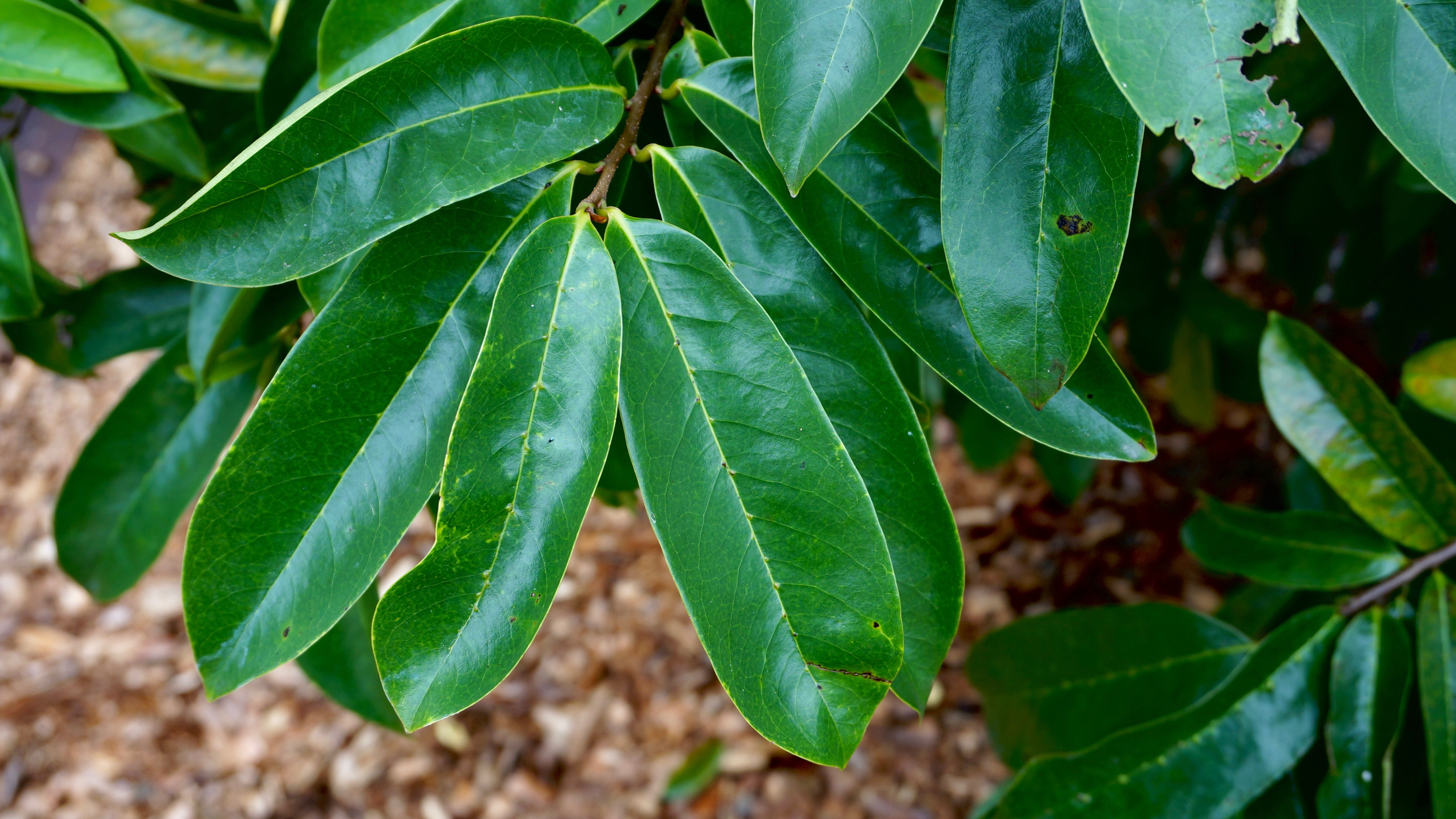
The leaves are dark green and alternating. Full grown leaves are about 7 inches long and 2 inches wide. The root system is shallow and very fibrous. I have not found any large and thick roots around my soursop tree. The soursop can be somewhat ornamental because of its dense dark green foliage and Christmas tree shape.
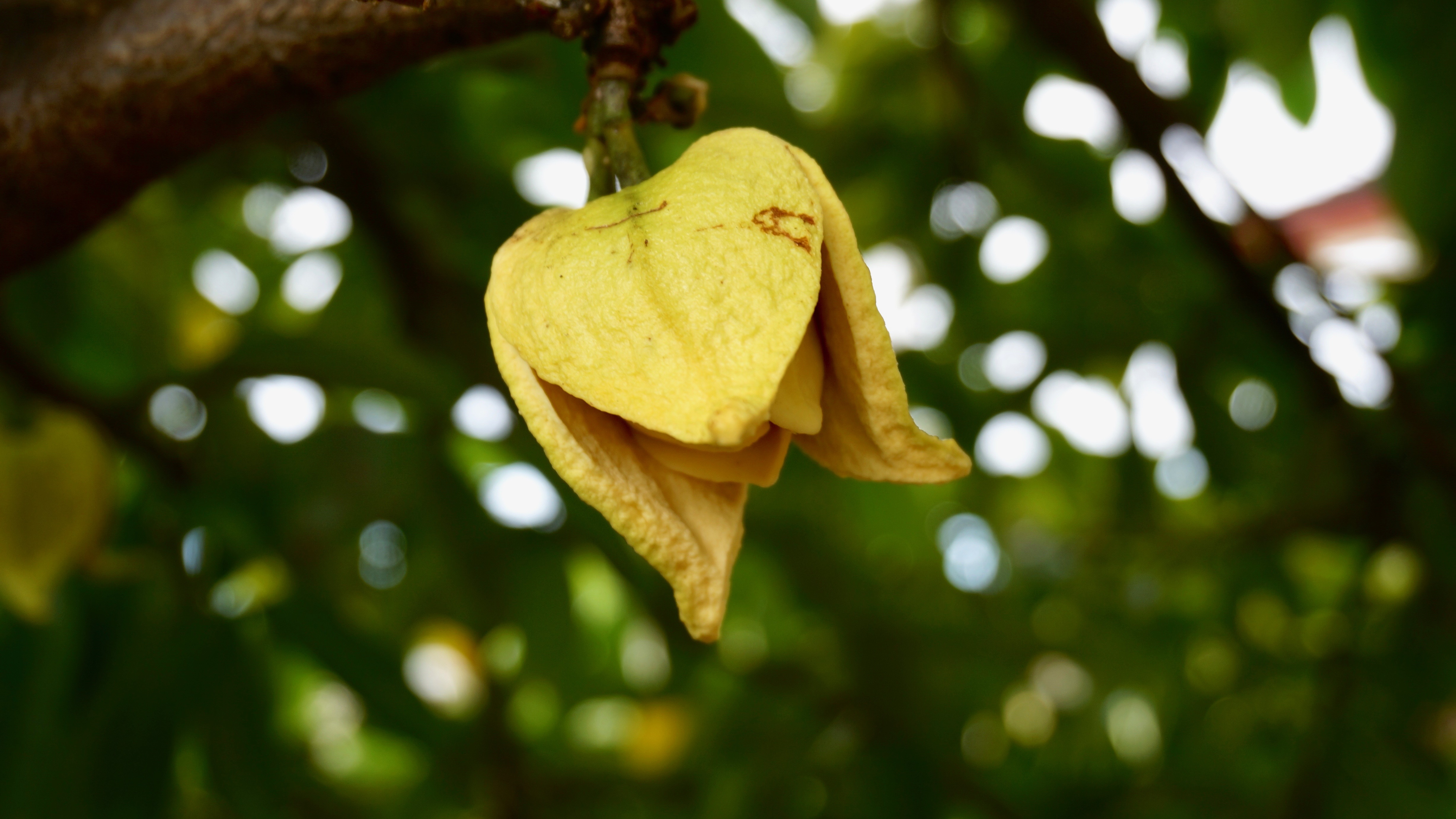
Growth Habit of the Flower
Soursop flowers are very unique. The flowers can reach 2 inches long and wide. They are borne singly on the branches or trunk of the tree, but I have seen some flowers growing all together in a clump.
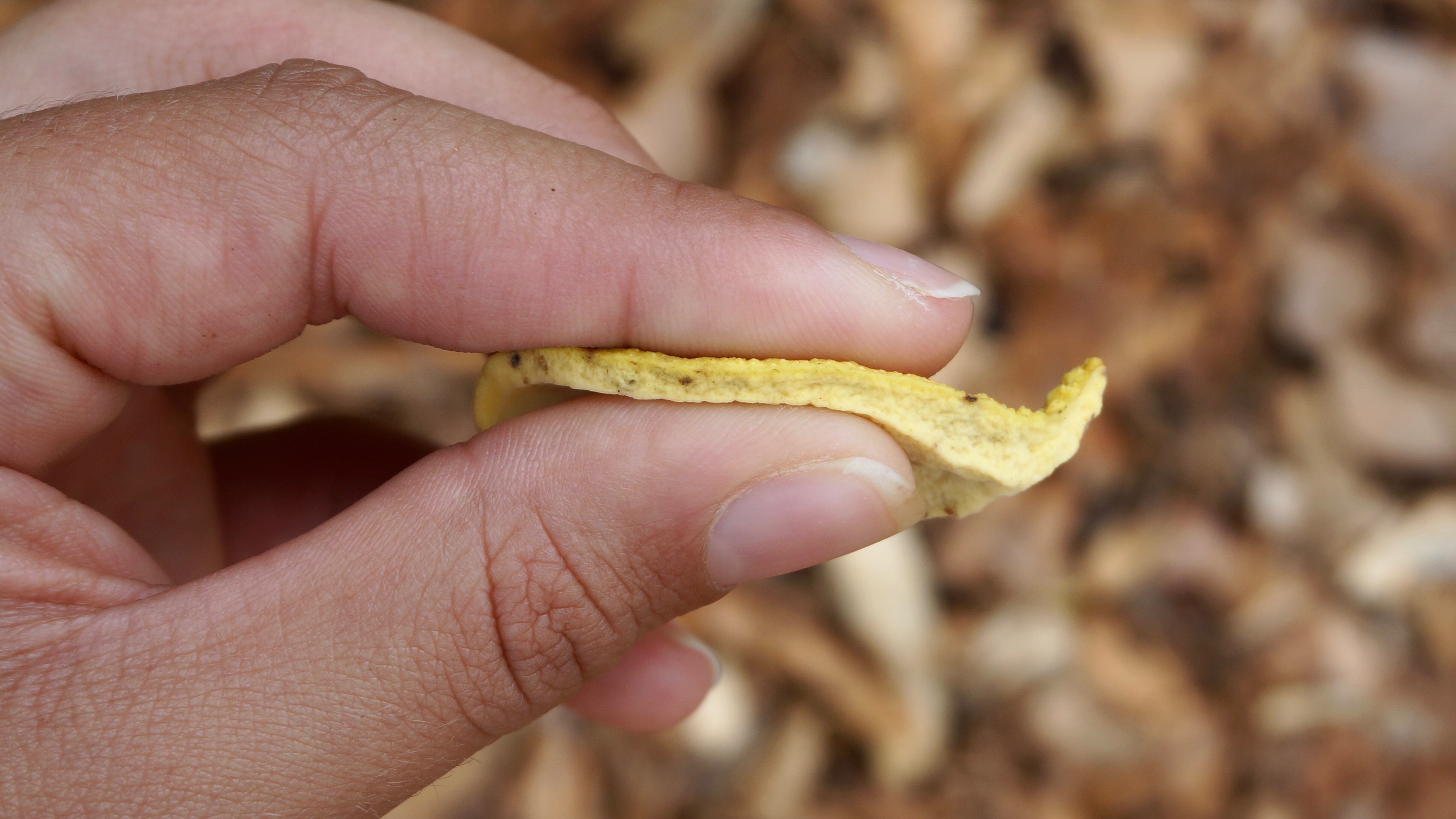
The flower has six triangular shaped yellow petals.
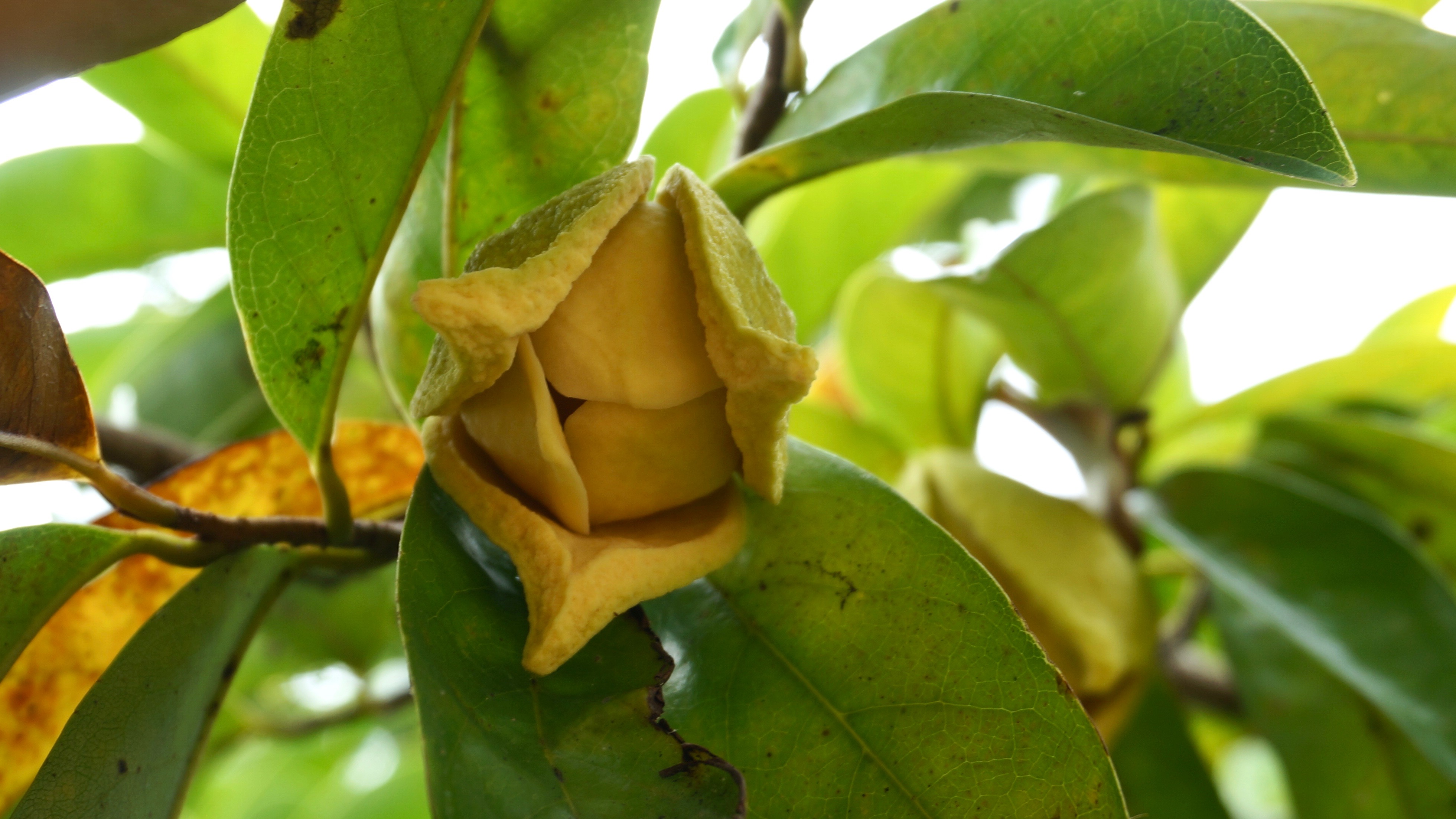
The three outer petals are very thick and separated to reveal the inner petals. The three inner petals are not as thick and they are close together even when the flower is fully open.
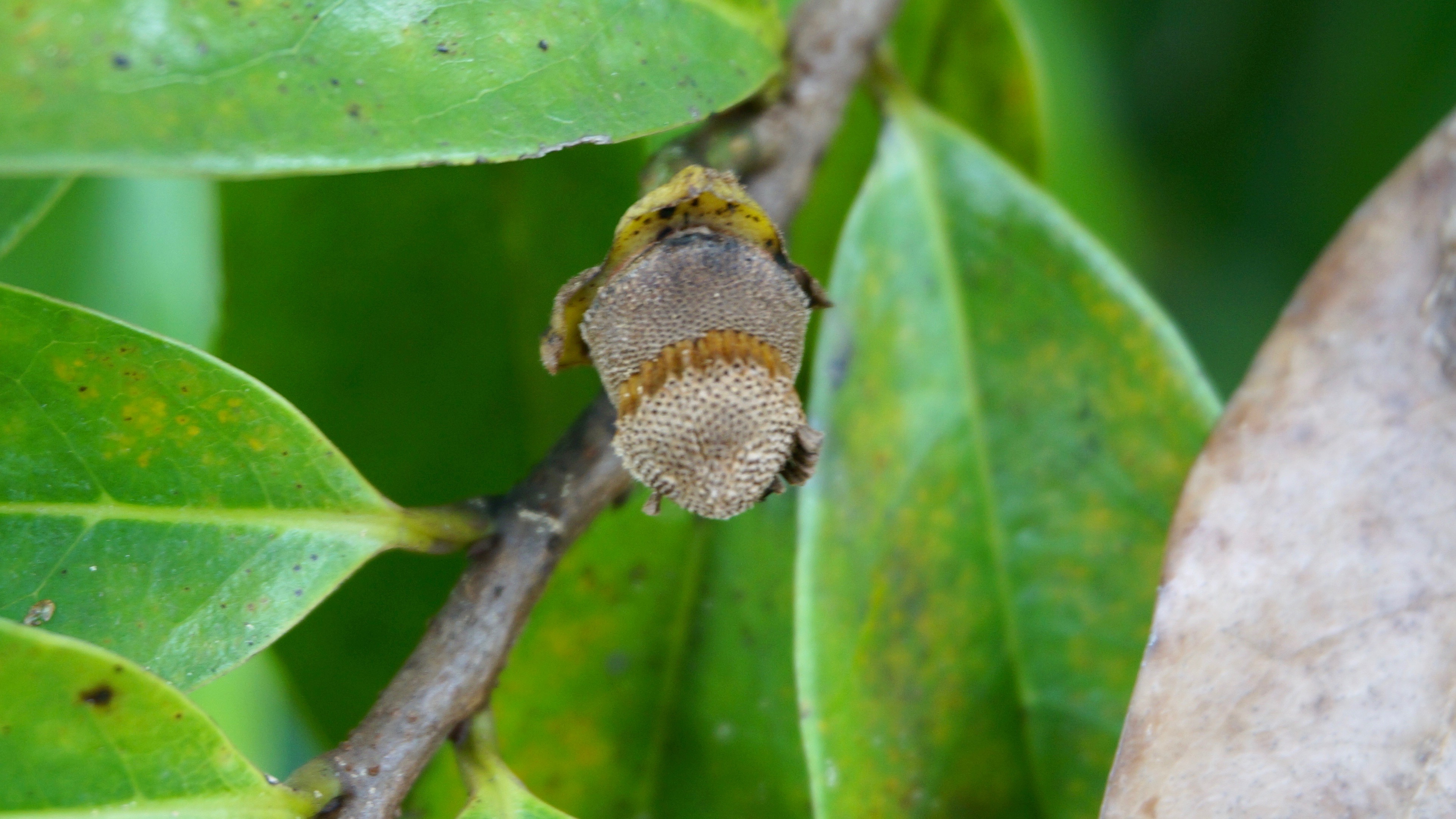
This is the soursop flower once the petals have fallen off and the reproductive parts are exposed.
All of these petals will fall off and expose the flower’s reproductive parts. Soursop flowers have both male and female parts, so the flower can pollinate itself or another flower on the tree. In the tree’s ideal climate, it will produce flowers all throughout the year.
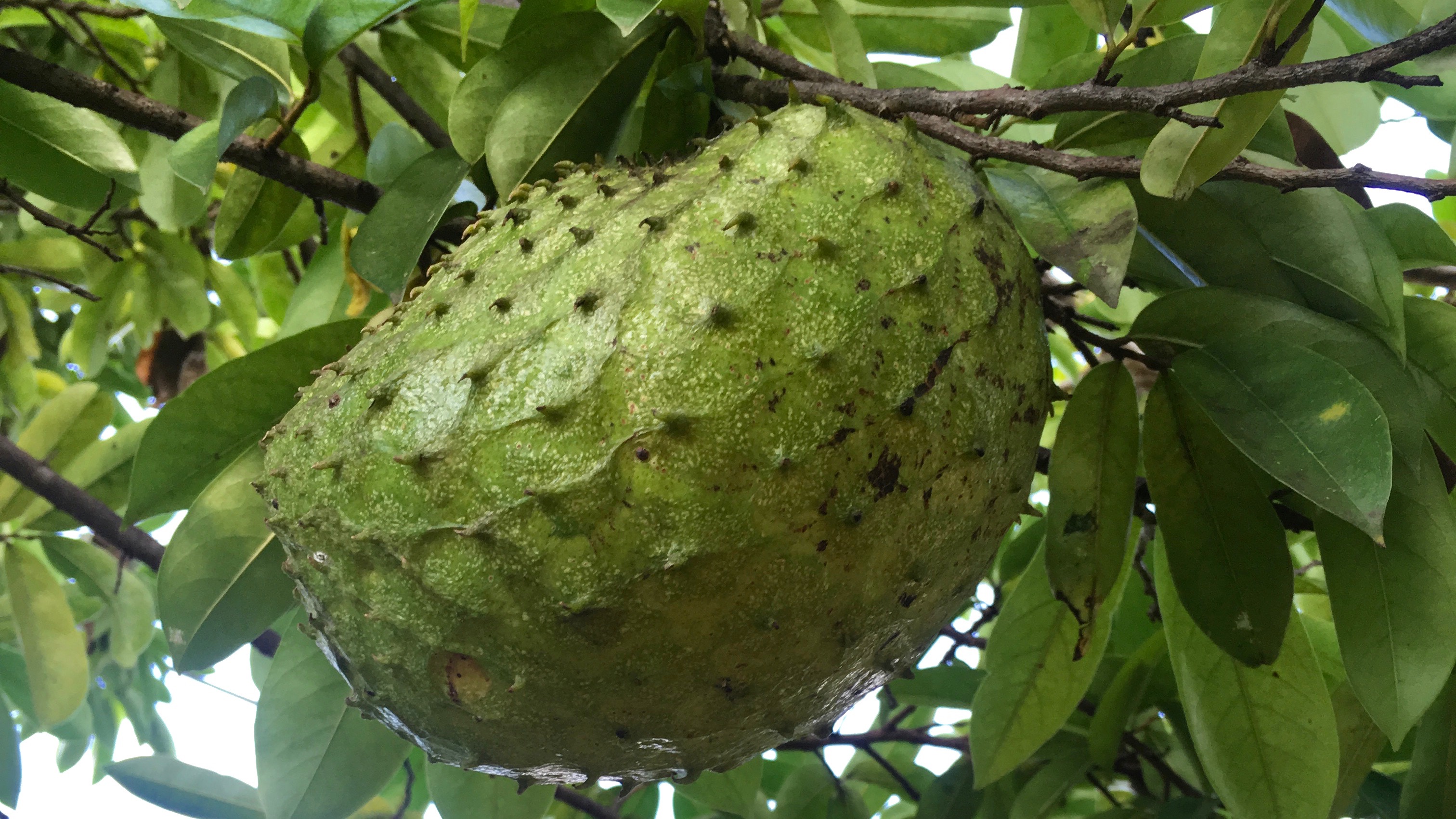
Growth Habit of the Soursop
The soursop fruit varies significantly in size and shape. A mature fruit can be anywhere from 4 to 12 inches long and up to 15 pounds in weight. Overall, the fruit has an oval shape, however, it can have a heart shape or irregular shape. The ripe fruit has a light green inedible skin that is thin but strong. The entire fruit is covered in soft spines. When the fruit is young it is dark green and the spines are hard and close together. As the fruit grows the spines begin to separate. At peak ripeness the spines should easily fall of if you run your finger over them.
The fruit is compound. This means that multiple ovaries have come together during the fruits development to form one large fruit with multiple seeds that are spread out throughout its flesh. Other species in the Annona family also produce compound fruit, and some have many seeds in one fruit. Luckily, the soursop has few seeds compared to the other species. The inedible seeds are oval shaped and somewhat flat.
The soursop flesh is segmented. A segment might contain a seed or not. The segments can be very fibrous depending on the cultivar. The tree that we have produces fruit with flesh that is very creamy and juicy. The fiber that it does have is very insignificant. Since the tree flowers throughout the year it is possible to harvest fruit throughout the year. However, the tree has a main fruiting season during the warmer months. In Florida this season is from June to September.
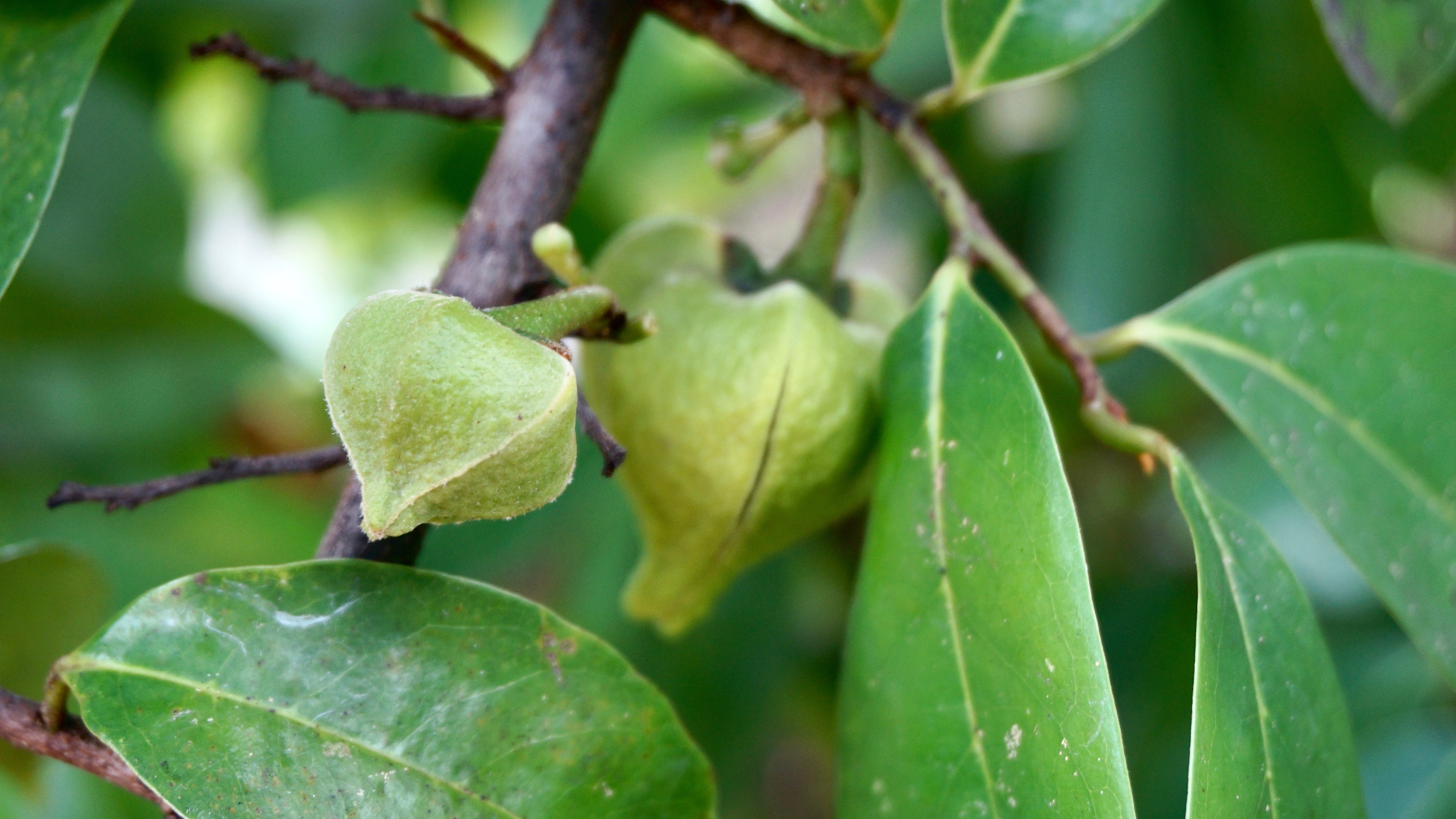
Growing Conditions of the Soursop
This fruit tree is truly tropical. Young tress can be killed by frost and older trees will drop their leaves or die back. It does best in well drained and rich soils, but it can tolerate other types of soil. The tree also prefers full sun and a moderately humid climate. My parents say that the fruits in Cuba grow much larger than the fruits grown in the Florida mainland. I think this has to do with the soil type and cooler weather of Florida.
The soursop tree is very likely to be toppled by strong winds because of its shallow and fibrous root system. During Hurricane Irma our soursop tree was the first of our trees to topple over. Fortunately it fell onto a fence and the fence was able to hold it up, so it didn’t completely fall over. The tree should be well watered because it isn’t drought tolerant. You can also mulch around your tree to maintain more consistent soil moisture levels around your tree. If you want your soursop tree to fruit I would not recommend growing it in a container, unless the container is very large.
Propagation
The soursop tree is most commonly grown from seed. You can purchase seeds here. Seed grown trees take around 3-5 years to reach maturity and bear fruit. Since the trees do not grow very wide they can be planted a bit closer together. Asexual propagation is done by cuttings, air layering, and grafting. The budwood is normally grafted onto soursop seedlings but it can also be grafted onto the Custard Apple (Annona reticulata), the mountain soursop (A. montana), and the pond apple (A. glabra). We currently have three seed grown trees with one mature enough to bear fruit.
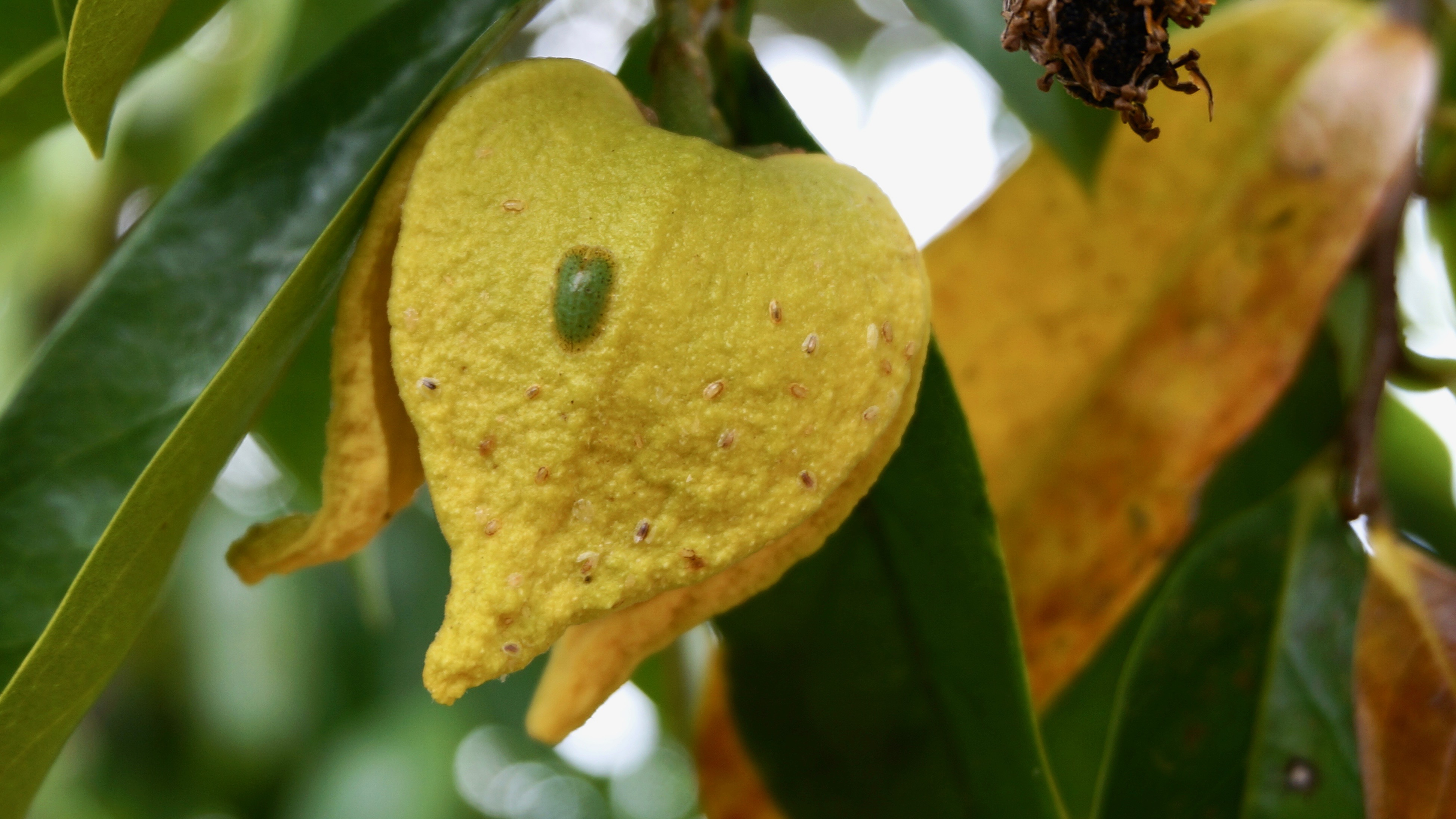
Pests
There are a few different pests that affect the soursop. The only pest I have experienced is aphids. I am not sure of the species, but the only aphids I have seen on the tree are rather large and dark green. There are ants that are continuously farming these aphids. Sooty mold begins to grow on the leaves when the aphid infection is at its worse. The aphids are found on the green stems, flowers, fruits, and under the leaves. Our main method of control has been to spray the affected areas with the hose. This kills the aphids as they are ripped off of the tree. The ideal method would be to control the ants. If there were no ants farming the aphids then there wouldn’t be much of an aphid problem.
Some other pests of the soursop that have not affected our tree are mealy bugs and fruit flies. In very humid areas the trees might not bear fruit and if they do produce fruit then it is often partially rotted.
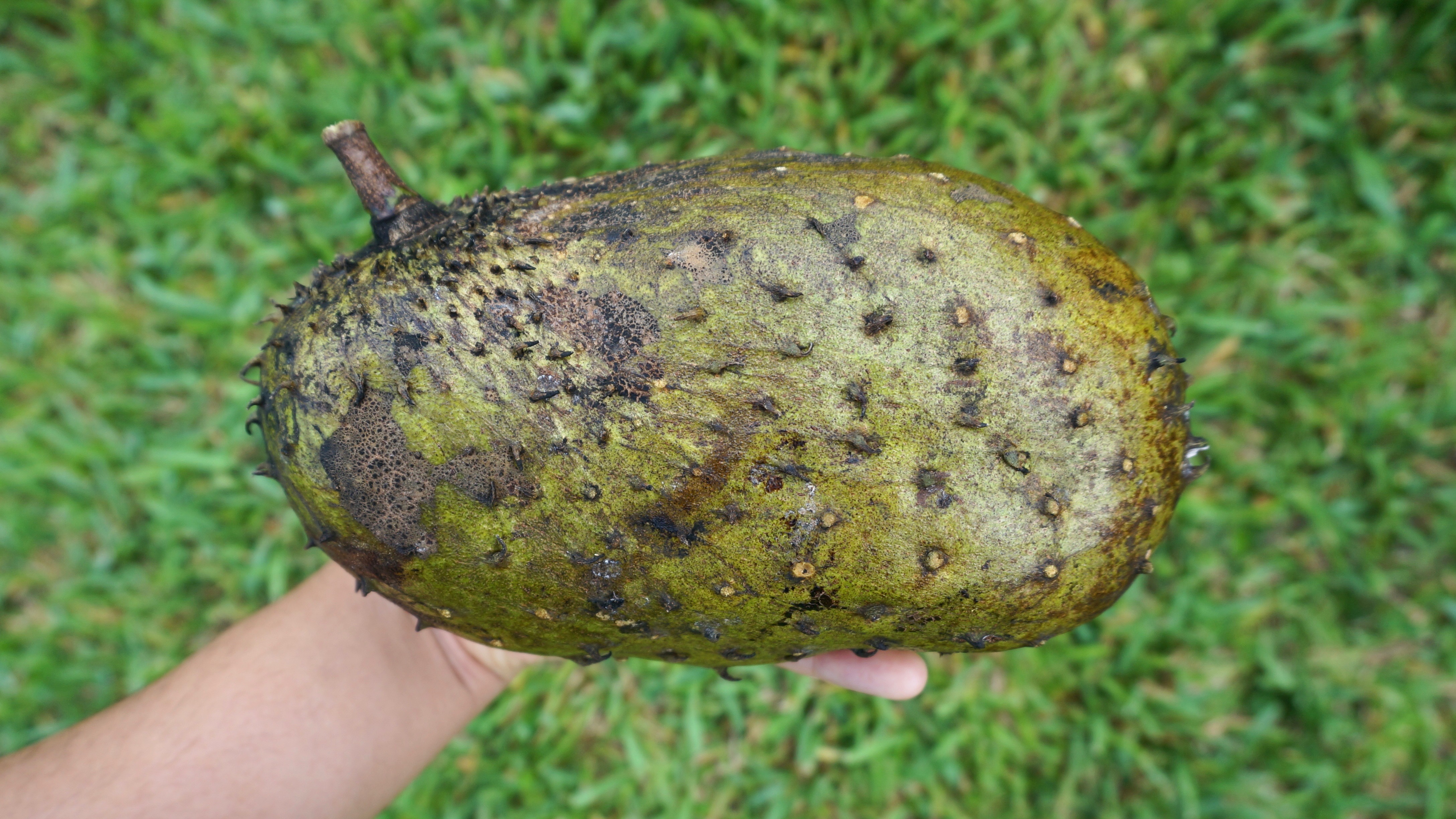
Uses
Harvesting the Fruit
The soursop has many uses. The fruit is harvested while fully mature but under ripe. It is difficult to know when the fruit is ready because the color change is not significant. It is ready to harvest once the fruit becomes light green and the spines are soft and easily fall off. We wait until the fruit becomes slightly soft. Once it is slightly soft you must remove it from the tree because it’ll quickly soften. Once it is fully softened, it is likely that the fruit will fall from the tree and smash on the ground. The ideal soursop has a pleasant sour and sweet flavor.
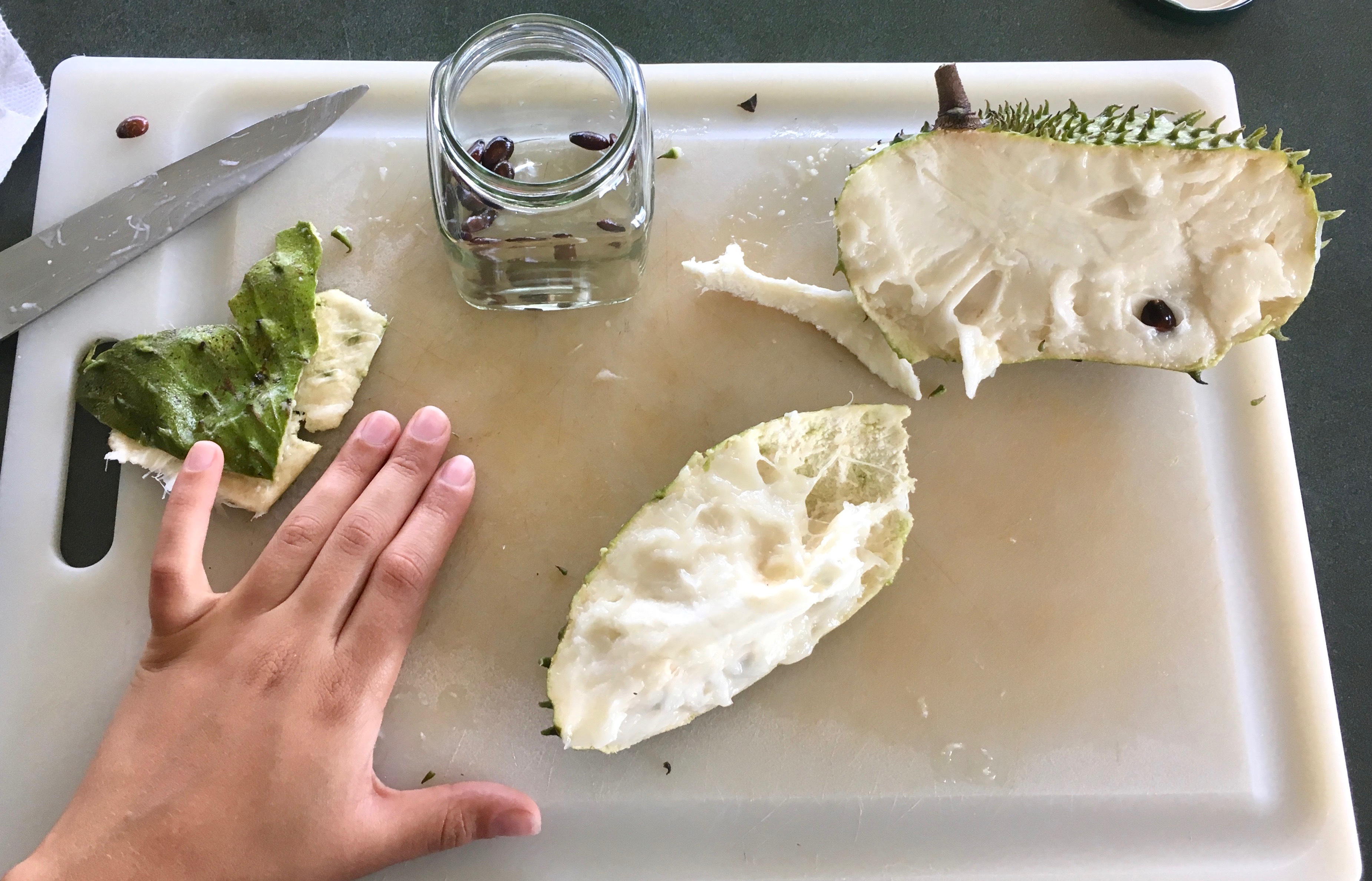
Eating it Fresh
Fruit that is juicy and creamy is normally eaten out of hand. You can easily peel the fruit and tear the flesh apart with your hands. You can also cut the fruit in half and then into pieces. Since the fruit’s segments are attached together it can be difficult to simply scoop the flesh out with a spoon. The seeds easily separate from the flesh. They should not be eaten because they are toxic and therefore inedible.
Using it in Recipes
Some fruits are more fibrous and sour. These are used to make various desserts. A very common drink is champola. This drink is made by separating the juice from the flesh and seeds. It is then mixed with water and sugar. The deseeded flesh can also be blended with water and sugar and then strained to make the drink. The fruit is also used to make preserves, ice cream, and custards. The pulp of the fruit is commonly seen sold frozen in latin grocery stores.
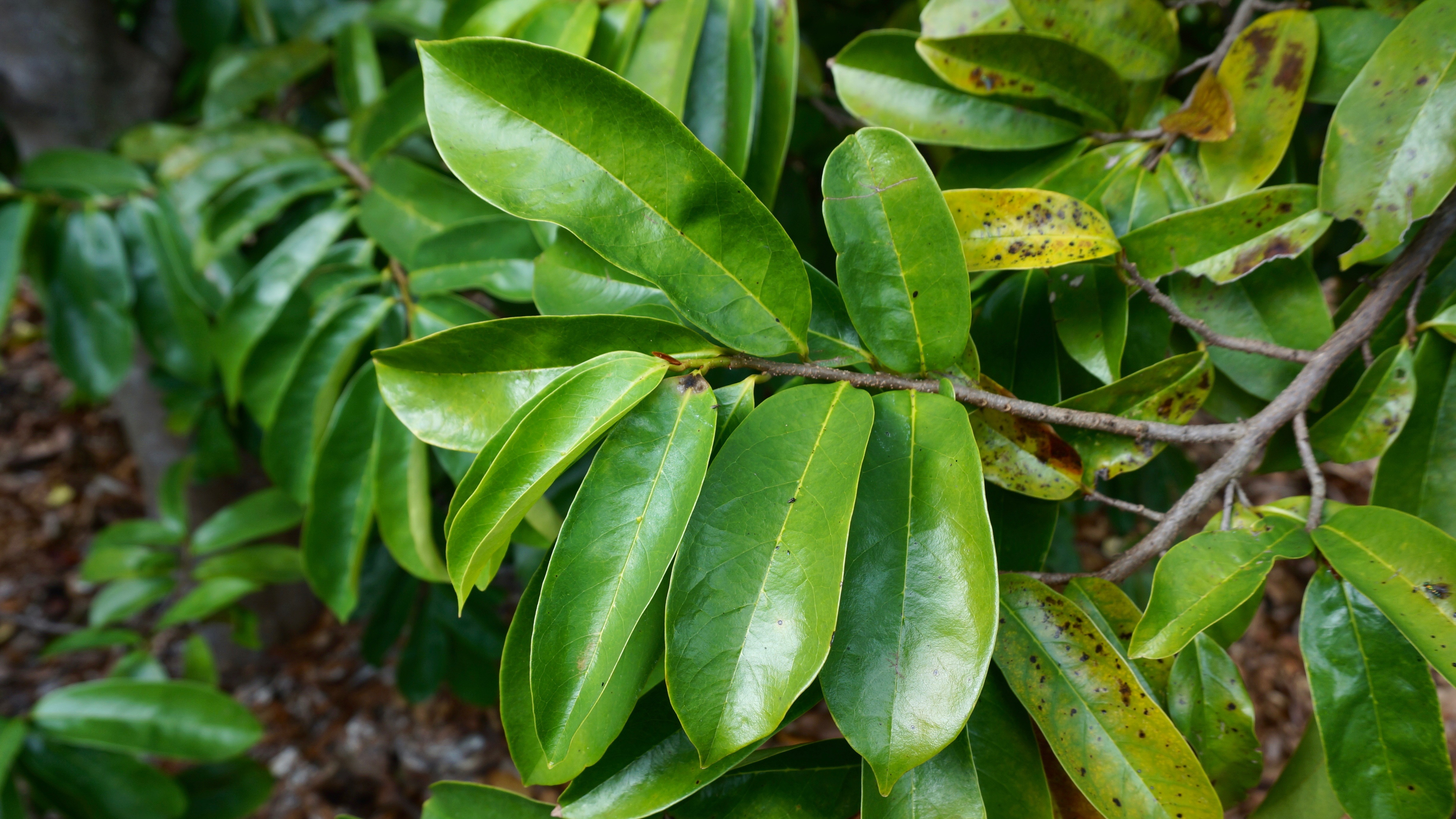
Using it Medicinally
The soursop has gained popularity in recent years for its medicinal purposes. The leaves are dried and made into a tea which is said to help stop cancer. There have been some studies showing the ability of soursop extract to kill certain cancer cells, however, the evidence for this is minimal.
The soursop is a highly regarded fruit. Have you had the opportunity to try it? Do you have your own tree? Comment and let me know down below. If you want to learn more about other tropical plants and trees you can go here.
See what other fruit trees I am growing in South Florida besides the soursop.
My niece got healed of cancer using the leaves of soursop and olive oil. She lives in Canada.
Planning to plant my own tree . Where can I get the seeds?
My tree (in Miami, Florida) did not produce fruit last year even though it has produced before. It lost its leaves 3 times in a year and this year so far it has lost leaves twice. What can I do to help it produce fruit.
Hi, so I have grown a soursop tree from seeds from the Philippines. In the 4th year, (last year) it produced fruit.
They call it Guyabano
I also purchased from a local grower here in West Palm (Zills), 12 small trees, and planted on my 1 acre farm because they grow slow from seed.
The leaves do drop in cold weather, but quickly grow back.
The only pests I saw was a small black caterpillar eating the leaves last year, which I hand picked off.
I have never seen aphids, but ants are easy to control by spreading a thick layer of vaseline around the truck of any tree, about 1 inch. The won't pass it.
I have a small fruit now on my backyard tree!
My soursop fruit is falling off .
I don't know what to do maybe is the rain that is disturbing the growth.
How are ants controlled in soursop
really helpful your article but my soursop not produce the fruit after hand pollinated, its going to be brown and not produce the fruit so what to do for produce fruit?
Unfortunately I really do not know what it could be. These are some of the possibilities. They tree might still be too young to grow a fruit. It might be getting exposed to cold temperatures that are calling the fruits to die and fall. The tree also might not be strong enough to grow the fruit.
Your web-site was very educational. Thanks for sharing your knowledge. I have had Sour sop in a container for 4 years. I want to but it in the ground in the spring. I’m in zone 9b. Not sure where to plant it. We do get frost in my area.
Thank you for your kind words. Soursop will get damaged by frost. Try to find a micro climate on your property. David the Good on his website the https://www.thesurvivalgardener.com has a lot of information about micro climates. Apart from planting location you can definitely protect the tree on the coldest nights of the year. I don't have much experience with it but there are a lot of ideas online. Just search for "frost protection fruit tree".
My soursop is over 4 years now. It produces flowers but once l see it and come back 3 or 5 days later, it would have disappeared. Nothing will be left after the petals fall off. Please what could be the reason?
I am not sure. Perhaps it is because your flower is not getting pollinated. I don't have to hand pollinate my soursop flowers where I live but I do know that some people need to hand pollinate in order to get a good fruit set. When the thick yellow petals fall off there should be a little nub that remains that will grow into the fruit. I am sorry I could not be more helpful. In my post under the section "growth habit of the flower," if you look at the third picture, that is what will remain when the petals fall off.
I live in Tampa, Fl and have a sour sop that I grew from a seed. The tree is on the east side of the property and is about 9 feet tall. I've had it for at least 4 years, and yet is has not produced fruit, nor flowers for that matter. Any suggestions to encourage it to fruit?
Is the tree planted in the ground or in a pot? Potted trees tend to be less vigorous than in ground ones. Our tree took a couple years before it start flowering but patience is honestly the biggest thing with fruit trees. I have heard that sometimes people hammer some nails into the trunk of a tree to force it to fruit. I have not tried this but it is worth looking into it.
My soursop tree is 5 years old . It has plenty of flowers but only bear me one fruit. I wonder if you could show me step by step how to hand pollinate the flowers . How do I collect the pollen? When is the stigma ready for pollination? Is this done in the morning or evening?
Thanks
When our tree was young it flowered a lot and only bore a few fruit. It might be that the tree is just simply to young to carry a heavy crop. After our tree got older it started holding onto a lot of fruit! I have not tried hand pollinating our soursop but here is a link to a video of someone doing it. https://www.youtube.com/watch?v=nm1-vuhFBPY
Mine too had only two fruits to maturity and only once!. Flowers just fall off. I think it is lack of fertilisation. Richard
I have the same problem.
Wonderful profile of this fruit! I've only had soursop a few times, but I really enjoyed it. As always, I'm envious of your climate zone, where you can just wander into the backyard and pick fresh soursops right off the tree.
It is such a delicious fruit. I am very fortunate to live in a climate where it can grow. Unfortunately, South Florida is not warm enough. It will grow but it won't thrive like in some other warmer areas. When the temperatures drop into the 40s here then the tree drops almost all of its leaves. A few fruit is better then no fruit though!
I have a siursop tree rhar i planted 5 years ago. this year this year the fruit beared a lot of fruits though they are still young. I discovered that some of the fruits have black patches on rhem which is worry some. i also saw a lot of ants on the tree Pls what should i do
I am not fully sure what the black patches are. I had black patches on my soursop tree. The leaves, young stems, and fruit would get black patches. The black patches were sooty mold. Search up some images of sooty mold and compare. The sooty mold was caused by ants farming scales on my soursop tree. The ants protect and spread the scales across the tree. The scales attach to young stems, leaves, flowers, and fruit. They suck the sap of the plant and then produce a sweet substance that the ants eat. The sooty mold grows due to the sweet substance the scales produce. The tree might have aphids instead of scales. Both aphids and scales are similar. If this is what you have, then to resolve the issue the best thing to do would be to kill the ant colony. We did this by removing some nearby logs where the ants were nesting. Or you can also use an ant bait that is intended to kill the colony. To prevent the ants from getting on the tree you can use vaseline because the ants get stuck in it. Spread a thick amount of vaseline onto the main trunk of the tree a few inches off the ground. This worked very well for a june plum tree that I have that was infested with scales and was growing sooty mold. The tree recovered since the ants were no longer able to get on the tree. After a couple weeks I found that the vaseline was still stuck on the trunk and was damaging the bark so it is best to scrub it off in a few weeks when the tree recovers. After spreading the vaseline I got rid of the scales by pruning off very diseased branches and then using the hose to strongly spray the scales off which kills them. You can also opt for using diatomaceous earth. After the scales are gone and no more ants are farming any aphids or scales you will see the sooty mold disappear. We were able to resolve this issue on our soursop mainly from removing the ant nest and spraying the scales off. On our june plum tree we used the vaseline. The sooty mold does not seem to cause significant damage to the fruit or tree unless it is very heavily covered with it. I hope this was helpful. This is the only experience I have with black patches on my fruit trees/fruit.